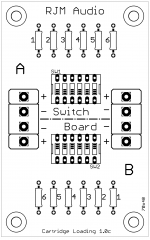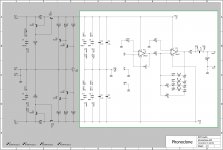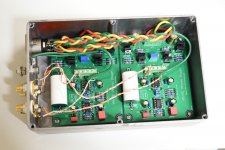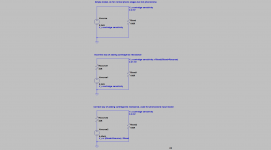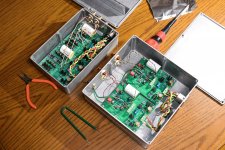What Jose said.
You get a couple of hundred pF of input capacitance "free" from the phono cable, but if you want to add more you just put a capacitor across the VSPS inputs.
The VSPS has no cartridge loading options, and no default input capacitance, but both of these can be added using the Switchboard, shown below, which connects between the VSPS and the input.
You get a couple of hundred pF of input capacitance "free" from the phono cable, but if you want to add more you just put a capacitor across the VSPS inputs.
The VSPS has no cartridge loading options, and no default input capacitance, but both of these can be added using the Switchboard, shown below, which connects between the VSPS and the input.
Attachments
Emerald 10c
I built Emerald 10c (evaluation), as pictured. It replaces my Phonoclone 4.5.
Differences between previous phonoclone is NE5534A used instead of OP27, and 55 dB gain instead of 60 dB. S-Reg section is identical.
It works as advertised. I think it sounds rather better than the Phonoclone, but it is early days yet. Smoother, better sense of rhythm, more articulate and tuneful bass, greater and more realistic delineation of individual instruments. It's qualitatively similar to the PC4 however, the differences would be on the level where it might just be down to the change in op amps, something I will look at soon.
To confirm the gain, in my system the amp is 30 dB and preamp 6 dB, 55 dB phono gives 91 dB total, this is the least gain I could live with. Before I had 60 dB phono and 12 dB gain, 102 dB gain, I was struggling to get the volume control out of the bottom of the range, so that rather precisely brackets the total linestage gain I need as between 61 and 72 dB. YMMV but I think 39/59 dB as the BOM defaults of the Emerald is about right.
I built Emerald 10c (evaluation), as pictured. It replaces my Phonoclone 4.5.
Differences between previous phonoclone is NE5534A used instead of OP27, and 55 dB gain instead of 60 dB. S-Reg section is identical.
It works as advertised. I think it sounds rather better than the Phonoclone, but it is early days yet. Smoother, better sense of rhythm, more articulate and tuneful bass, greater and more realistic delineation of individual instruments. It's qualitatively similar to the PC4 however, the differences would be on the level where it might just be down to the change in op amps, something I will look at soon.
To confirm the gain, in my system the amp is 30 dB and preamp 6 dB, 55 dB phono gives 91 dB total, this is the least gain I could live with. Before I had 60 dB phono and 12 dB gain, 102 dB gain, I was struggling to get the volume control out of the bottom of the range, so that rather precisely brackets the total linestage gain I need as between 61 and 72 dB. YMMV but I think 39/59 dB as the BOM defaults of the Emerald is about right.
Attachments
This is the emerald: 171216103103 E10c 35 - on the border.wav - Google Drive
This is the phonoclone: 171216215943 pc4 28 - on the border.wav - Google Drive
If you get mixed up, "E10c" is code for emerald, "pc4" is phonoclone.
The were recorded from the output of the phono stage into my Kenwood recorder, digitized at 48 Khz, 16 bit. The Emerald gain is 55 dB, the Phonoclone nominally 58 dB, but as a result of the quirk of the current input stage I realized the DL-103 gets 3 dB extra gain relative to a normal 100 ohm input, so they are actually 6 dB apart, normalized here by the recording gain of the Kenwood.
Do they sound different?
(reference track: Al Stewart, "On the Border" from Year of the Cat.)
This is the phonoclone: 171216215943 pc4 28 - on the border.wav - Google Drive
If you get mixed up, "E10c" is code for emerald, "pc4" is phonoclone.
The were recorded from the output of the phono stage into my Kenwood recorder, digitized at 48 Khz, 16 bit. The Emerald gain is 55 dB, the Phonoclone nominally 58 dB, but as a result of the quirk of the current input stage I realized the DL-103 gets 3 dB extra gain relative to a normal 100 ohm input, so they are actually 6 dB apart, normalized here by the recording gain of the Kenwood.
Do they sound different?
(reference track: Al Stewart, "On the Border" from Year of the Cat.)
No bluff. I can barely hear any difference, so I'll want to make it as easy for everyone as I can.
I find the Emerald has a wider sound-stage with a better bass definition, but the PC - as you perhaps because of familiarity - is "likeable" with a pleasant, integrated tone. The more I flip back and forth the more I warm to the Emerald though. The PC sounds a little rough in comparison and missing details, especially the basslines.
I warn that this is unlikely to be so much the circuit per se. but the details of the builds. I have to swap over op amps and see what that does for things.
I find the Emerald has a wider sound-stage with a better bass definition, but the PC - as you perhaps because of familiarity - is "likeable" with a pleasant, integrated tone. The more I flip back and forth the more I warm to the Emerald though. The PC sounds a little rough in comparison and missing details, especially the basslines.
I warn that this is unlikely to be so much the circuit per se. but the details of the builds. I have to swap over op amps and see what that does for things.
I have a confession to make. I've been calculating the phonoclone gain slightly wrong all these years.
Originally the claim by the 47 labs phonocube was that the zero ohm input impedance meant "all the current from the cartridge is amplified" but it never properly sunk it what that actually meant.
What it actually means is that in current source terms the cartridge is operating unloaded, instead of into 100 ohms as specified and as calibrated for. The cartridge sensitivity of 0.3 mV is given for the conditions of 100 ohms load. To calculate out the gain properly, the voltage source needs to be multiplied by ((Rload+Rsource)/Rload), or about 3 dB in the case of the Denon DL103.
The correction for many MC carts is going to be smaller.
Here at RJM Audio we've always been more trusting of our ears than out brain, and even though the old worksheet gave a recommended R2 of 1.3k for the DL103, the recommended BOM has always specified 1k and that's what I've always used personally. Turns out 1k is quite close to the "correct" value of 800 ohms. By correct, I mean CD level output. Anything between that value and 0.7x will be fine.
Originally the claim by the 47 labs phonocube was that the zero ohm input impedance meant "all the current from the cartridge is amplified" but it never properly sunk it what that actually meant.
What it actually means is that in current source terms the cartridge is operating unloaded, instead of into 100 ohms as specified and as calibrated for. The cartridge sensitivity of 0.3 mV is given for the conditions of 100 ohms load. To calculate out the gain properly, the voltage source needs to be multiplied by ((Rload+Rsource)/Rload), or about 3 dB in the case of the Denon DL103.
The correction for many MC carts is going to be smaller.
Here at RJM Audio we've always been more trusting of our ears than out brain, and even though the old worksheet gave a recommended R2 of 1.3k for the DL103, the recommended BOM has always specified 1k and that's what I've always used personally. Turns out 1k is quite close to the "correct" value of 800 ohms. By correct, I mean CD level output. Anything between that value and 0.7x will be fine.
Attachments
Last edited:
No bluff. I can barely hear any difference, so I'll want to make it as easy for everyone as I can.
I find the Emerald has a wider sound-stage with a better bass definition, but the PC - as you perhaps because of familiarity - is "likeable" with a pleasant, integrated tone. The more I flip back and forth the more I warm to the Emerald though. The PC sounds a little rough in comparison and missing details, especially the basslines.
I warn that this is unlikely to be so much the circuit per se. but the details of the builds. I have to swap over op amps and see what that does for things.
Hmmm. Maybe it's just me but I find the bass to be fuller in the PC4 version, and overall sound quality is better. It just has more body. Frankly not a lot of difference to my ears. But I'm old and my ears ain't great. I don't notice much difference in dB between the two clips so I don't think that's a big problem for me. I'm listening at the moment through ear buds so that is also a factor. I just don't get soundstage when listening through headphones or earbuds. Perhaps I'll get a chance to listen through speakers soon.
Round two, op amps switched between preamps, recordings more carefully gain matched by adjusting the level to nominal 60 dB net. [Emerald +5 dB, phonoclone -1 dB]
Emerald 10c with OP27 171217141945 on the border emerald 34 op27.wav - Google Drive
Phonoclone 4.5 with NE5534A 171217144252 on the border phonoclone 26 ne5534.wav - Google Drive
I no longer know what I'm hearing, my ears are so tired. The only thing I can latch onto here is I don't think I like the OP27 all that much.
Emerald 10c with OP27 171217141945 on the border emerald 34 op27.wav - Google Drive
Phonoclone 4.5 with NE5534A 171217144252 on the border phonoclone 26 ne5534.wav - Google Drive
I no longer know what I'm hearing, my ears are so tired. The only thing I can latch onto here is I don't think I like the OP27 all that much.
I'm confused.
Are you doing a comparative test between phono stages or between opamps?
If the former you can better have the same opamp in both phono stages and repeat with alternative opamps.
If the latter keep the phono stage of choice constant and roll the opamps.
And assuming we're talking about subtle differences I can imagine these would be mushed out by digitising them - making the test more or less useless.
I have, by the way, just plugged a fully burned in quartet of OPA27's into my Emerald build and am now languishing with a cup of coffee listening to Beethoven's 7th. Eyes closed and I'm in the Leipzig Gewandhaus. It's that good!!
Dutch Keith
Are you doing a comparative test between phono stages or between opamps?
If the former you can better have the same opamp in both phono stages and repeat with alternative opamps.
If the latter keep the phono stage of choice constant and roll the opamps.
And assuming we're talking about subtle differences I can imagine these would be mushed out by digitising them - making the test more or less useless.
I have, by the way, just plugged a fully burned in quartet of OPA27's into my Emerald build and am now languishing with a cup of coffee listening to Beethoven's 7th. Eyes closed and I'm in the Leipzig Gewandhaus. It's that good!!
Dutch Keith
I'm confused.
Are you doing a comparative test between phono stages or between opamps?
If the former you can better have the same opamp in both phono stages and repeat with alternative opamps.<snip>
Same PhonoStages with reversed OpAmps in a previous post The Phonoclone and VSPS PCB Help Desk
I have just run a double blind test with the NE5534A wav files. I burned them to CD in a 1-2 1-2 1-2 1-2 1-2 1-2 1-2 1-2 1-2 ordering and got Mrs O to select the starting point. The display was turned off.
They are very close, but having shuffled to and fro a few times, I preferred the PC4 by a short head. The Emerald was a bit 'glassy', the PC4 just sounded more 'right' but as I said before that may be because I am running a PC3.
They are very close, but having shuffled to and fro a few times, I preferred the PC4 by a short head. The Emerald was a bit 'glassy', the PC4 just sounded more 'right' but as I said before that may be because I am running a PC3.
As noted, I'm trying to compare the sound of the phono stage but since historically I have always used OP27 in the phonoclone, while the NE5534A is the default for the Emerald, I started the testing in that configuration then realized I needed to swap the op amps around to confirm that it was the circuit, not the op amp, that was responsible in any difference in sound I might hear.
As a side benefit, any sound quality that follows the op amp can be identified as belonging to that op amp.
A grand scheme, but in practice the whole thing was a bit of a bust except to confirm that the op amps don't seem to make much difference to the sound at all.
Yes, digitizing does "mush" all these differences - very apt description! - but the advantage is I can A/B the files multiple times in rapid succession on the computer audio system in a way that's simply not possible with a turntable front end.
I agree with Mr Onion in the relative qualitative difference between the phonoclone and Emerald (glassy vs. "right") [I'd say the Emerald is wider, more distant, PC more central and musically coherent], but I tentatively sit on the other side of the fence with my preference. The Emerald seems to be able to pull out just a little bit more subtle detail from the grooves.
I suppose I should be happy they are both good... for the Emerald at least that is mission accomplished.
As a side benefit, any sound quality that follows the op amp can be identified as belonging to that op amp.
A grand scheme, but in practice the whole thing was a bit of a bust except to confirm that the op amps don't seem to make much difference to the sound at all.
Yes, digitizing does "mush" all these differences - very apt description! - but the advantage is I can A/B the files multiple times in rapid succession on the computer audio system in a way that's simply not possible with a turntable front end.
I agree with Mr Onion in the relative qualitative difference between the phonoclone and Emerald (glassy vs. "right") [I'd say the Emerald is wider, more distant, PC more central and musically coherent], but I tentatively sit on the other side of the fence with my preference. The Emerald seems to be able to pull out just a little bit more subtle detail from the grooves.
I suppose I should be happy they are both good... for the Emerald at least that is mission accomplished.
Further thoughts on preamp gain.
The unique advantage of the phonoclone is the self-compensating voltage gain. The lower the DC resistance of the cartridge, the higher the gain. Since the cartridge sensitivity closely correlates with the coil resistance, a fixed value of R2 will give the correct gain for a much wider selection of MC cartridges than the Emerald with a corresponding fixed set of resistors.
For example, if the phonoclone is set up for a DL103 (40 ohms, 0.3 mV) as R2= 750 ohms for 60 dB it will also give the correct output level for cartridge X (13 ohms and 0.1 mV), or Y (5 ohms and 0.045 mV) as the gain will be increased to 66 dB and 74 dB, respectively, automatically, just by connecting the cartridge.
With the Emerald you would need to adjust the gain set resistor each time, or leave it set to a fixed gain and deal with the difference in output using your pre-amplifier.
Since the headroom in these op amp circuits is not so high, it is better to set the gain so that the most sensitive (highest output) cartridge you plan to use is amplified to about CD line level output, and the rest somewhat lower, rather than choosing a gain that gives the ideal CD line level output with the middlemost cartridge sensitivity in the range. This I think is the basis for the argument for making an MC phono stage 55 dB rather than 60 dB: it reduces the risk of clipping/distortion when unusually high output cartridges are used. Also, though, generally speaking most audio systems have already too much gain, so having a source that is 3 dB above CD line level is more inconvenient than one which is 3 dB less.
As a general recommendation I suggest setting the "ideal optimized" phono stage gain for the cartridge you plan to use to 3 dB below CD line level. So instead of
cartridge sensitivity x phono stage gain = 316 mV (nominal CD line level, ~2 Vrms FS)
work with
cartridge sensitivity x phono stage gain = 223 mV (3 dB less than nominal CD line level, 1.4 Vrms FS)
as your design center point.
The unique advantage of the phonoclone is the self-compensating voltage gain. The lower the DC resistance of the cartridge, the higher the gain. Since the cartridge sensitivity closely correlates with the coil resistance, a fixed value of R2 will give the correct gain for a much wider selection of MC cartridges than the Emerald with a corresponding fixed set of resistors.
For example, if the phonoclone is set up for a DL103 (40 ohms, 0.3 mV) as R2= 750 ohms for 60 dB it will also give the correct output level for cartridge X (13 ohms and 0.1 mV), or Y (5 ohms and 0.045 mV) as the gain will be increased to 66 dB and 74 dB, respectively, automatically, just by connecting the cartridge.
With the Emerald you would need to adjust the gain set resistor each time, or leave it set to a fixed gain and deal with the difference in output using your pre-amplifier.
Since the headroom in these op amp circuits is not so high, it is better to set the gain so that the most sensitive (highest output) cartridge you plan to use is amplified to about CD line level output, and the rest somewhat lower, rather than choosing a gain that gives the ideal CD line level output with the middlemost cartridge sensitivity in the range. This I think is the basis for the argument for making an MC phono stage 55 dB rather than 60 dB: it reduces the risk of clipping/distortion when unusually high output cartridges are used. Also, though, generally speaking most audio systems have already too much gain, so having a source that is 3 dB above CD line level is more inconvenient than one which is 3 dB less.
As a general recommendation I suggest setting the "ideal optimized" phono stage gain for the cartridge you plan to use to 3 dB below CD line level. So instead of
cartridge sensitivity x phono stage gain = 316 mV (nominal CD line level, ~2 Vrms FS)
work with
cartridge sensitivity x phono stage gain = 223 mV (3 dB less than nominal CD line level, 1.4 Vrms FS)
as your design center point.
Last edited:
- Home
- Source & Line
- Analogue Source
- The Phonoclone and VSPS PCB Help Desk
